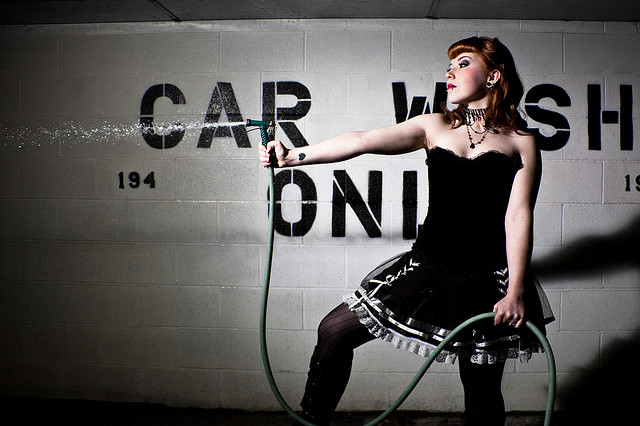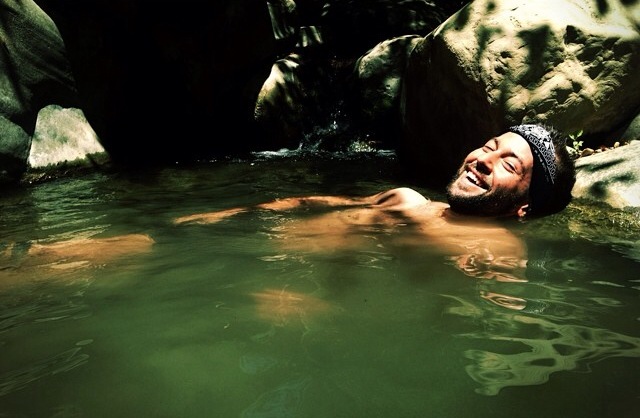Does L.A.'s Obsession With Image Trump The Need For Water Conservation?

California is in the middle of the nastiest drought it’s seen in over a century. And it turns out that the region could actually benefit from some of the behaviors that we have come to scoff at over the decades. But in sunny, sweltering Southern California, we have the Hollywood image to uphold. The value that we place in our overall appearances in L.A. often takes precedence over water conservation.
Social status plays a role in all of our lives. Look anywhere and you’ll see a brand that you have a connection to, whether that connection be positive or negative. BMW and Land Rover are vehicles of status that may impress us when we ask what someone drives. It bumps up their image and makes them look good.
But take that sparkling clean BMW that’s parked next to the perfectly trimmed lawn, and add three month’s worth of dirt and grime to the outer body. Place in that car a driver who has not showered in 90 days and who says he flushes his toilet only under certain circumstances. Now imagine he lives in Southern California.
Not normal, right? That’s because cleanliness and hygiene itself are symbols of success and social class.
But the drought in Southern California calls for action, even if those actions go against our norms. Perhaps even especially because they do. There's a claim that the current drought is actually a part of a much more serious and large-scale drought that North America has not seen since the year 1159. Yes, 1159. During this drought, we cannot continue feeling entitled to unlimited amounts of water. We need to put vanity, convenience and extravagance aside, even if it is by law enforcement and heavy fines.
Although an article posted this month in The San Jose Mercury News reports that statewide urban water consumption saw a decrease of 7.5 percent between July 2013 and July 2014, more can still be done. Northern Californians cut their water usage by 13 percent, while Southern California residents reduced their water consumption by only 1.7 percent. The difference in percentages is partially due to the much larger amount of water that Northern Californians normally use on average. However, strictly enforced water allotments and hefty fines in Northern California are credited for the large decrease over the previous year.
On Sept. 16, the same day that new data showed a 1 percent increase in state water usage over the past three years, the State Water Resources Control Board approved emergency regulations that allow law enforcement and water agencies to issue tickets of up to $500 a day for those wasting water. Fines can be imposed for using drinkable water to rinse driveways or water lawns to the point of runoff, for washing cars without a shut-off nozzle and for using potable water in non-circulating fountains.
Some claim that Southern Californians have been watching water since 1991, but as the demand for more conservation increases, it becomes more difficult to know what to do.
Unfortunately, we know what to do. We just don’t want to do it.

Information from the U.S. Geological Survey (USGS) website says that our daily 10-minute shower can use 30 gallons of water while washing a load of dishes in a dishwasher uses 20 gallons per load. Clothes use between 20 and 40 gallons per bundle when washed in a machine, and a toilet uses between one and three gallons with every flush.
So, we’re wasting substantial amounts of water on hygienic habits that began to become common daily regimens only within the past 150 years or so.
And in Los Angeles, cleanliness is next to godliness. The area is filled with "California Tens," exceptionally beautiful men (and women), due to the area being a hub for aspiring actors, actresses, models and the like. Beauty and hygiene are undeniably of utmost importance. It’s hard to imagine the beautiful people of Southern California walking along crispy yellow lawns, ducking into dust-covered cars to go to work with greasy roots and body oil-scented clothing.
It’s hard to imagine anyone doing that, really. And we actually don’t have to sacrifice clean, shiny hair for a recovering reservoir.
A Navy Shower—quickly wetting the body, shutting off the water while soaping up and shaving, and turning the water back on to rinse—can decrease water used to bathe by 95 percent, the Huffington Post reports. Whether taking a Navy Shower or a normal shower, you can also save water by placing a bucket beneath the spray while the water is warming up and keep it there to collect water as it bounces off your body. You can then use the collected water to flush the toilet.
There are tons of ways to conserve water. I think about them every time I toss a piece of clothing into my hamper, when I walk past miles of green grass on my college campus and when I flush.
For a week, my home restroom regime was, “if it’s pee, let it be. If it’s brown, flush it down.” Then I had a house guest and went scurrying into the restroom to flush before they could see “the way I live” and I haven’t yet gotten back into the habit. I try to wear my clothes twice or more without washing if it is possible, but with this heat it’s just so difficult.
It feels like focusing on our appearance is something that is unavoidable if we want to remain comfortable. And that is the issue. How much longer can we remain comfortable—clean, hydrated, with the visual pleasures of green lawns and running fountains—if the state runs out of water?
In Tulare County, wells are drying up, leaving some homes without any water at all. Residents are quoted in an NBC news article as feeling homeless or as if they live in an under-developed country. Some residents are forced to bathe with a small cup—and it isn’t by choice.
Without significantly changing our water consumption, it was estimated by NASA’s senior water scientist, Jay Famiglietti, in July of 2014, that California only had 12-18 months worth of water in stores.
READ MORE: California Has 12-18 Months Of Water Left
Walking past the lawns of green grass at USC’s University Park Campus, I found myself thinking about how unattractive and harsh the grounds would feel without the grass. Moments later I realized this was just my own pride in a symbol that signified wealth. A green lawn for me symbolizes affluence—the time and staff to care for a lawn is demonstrated in whether it is green and soft or crunchy and yellow. I found myself sitting by and very much enjoying the sound and scent of water flowing down a fountain after a stressful evening when just days before I was considering writing that fountains should be shut off countywide or further. For a moment, I was glad that I hadn’t written about it because maybe enough people would have agreed and fountains would cease to operate for my enjoyment amidst a hectic schedule.
And then I thought of how uncomfortable it could be not too long from now when we don’t have a choice as to how much water we use, because it’s gone.
And so even though I am afraid to say what follows, I do it in the hopes that maybe more people will join to whatever degree. I feel we need to make the choice to put our appearances and attachments to symbolism second in order to make water conservation a real priority.
I’m following in the steps of Chreighton and his #OneDayDirtier campaign.
Share this story within the next 48 hours, and for each share, I will go one day without showering.
If you want to go further than that, join the cause as well. Take to social media and share photos of your dirty cars, your massive pile of dirty laundry and anything fun, creative or quirky that you’re doing to save water and tag it with #OneDayDirtier. We can make a difference.
Contact Contributor Marisa Zocco here; or follow her on Twitter here.



